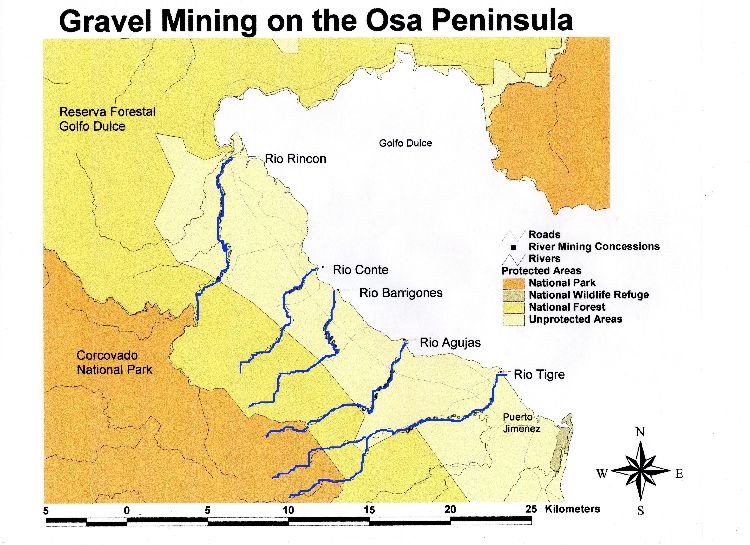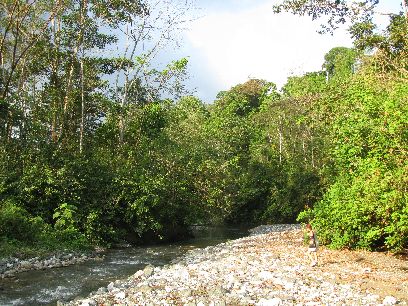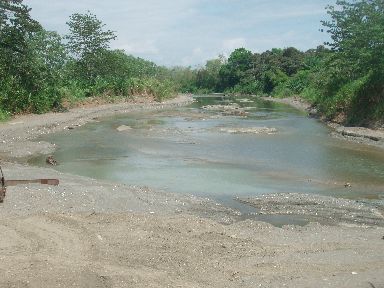Riverbed gravel mining Osa Peninsula

One concession has been awarded in 2008 over 2 kilometers in the Rio Tigre to Materiales del Occidente S.A. for extracting 345.600 m3 of gravel per year during the first two years and 201.600 m3 annually in each of the remaining six years. Another concession was awarded for similar quantities in Rio Rincón. Applications have been submitted for some 10 other concessions in Rio Tigre and the other rivers above.
Here below fotos of Rio Tigre, on the left where no gravel extraction took place, and at right the river below the bridge over the road to Puerto Jimenez after gravel extraction.



Court case EALA against mining company
In 2010, EALA and two other environmental groups have started a legal procedure at the Tribunal Contencioso Administrativo in San José against the award of a concession for gravel mining at Rio Rincón (see map above). According to scientists of the University of Costa Rica, gravel mining in this river would have very adverse environmental implications, see the 11 points below.
In December 2011, the Tribunal suspended the concession, a great temporary victory. The concession holder has appealed and after various decisions and audiences, the Appeals Court decided inSeptember 2013 to allow the concession holder to continue extraction. Currently, the parties are trying to reconcile.
The adverse effects of riverbed gravel mining are the following:
- IN-STREAM RIVERBED MINING IN COSTA RICA. According to US scientists and decades of research in USA, the current practices of in-stream riverbed mining allowed by Costa Rica's environmental authority SETENA and the department of Geology and Mines (GyM) imply a complete excavation of the entire riverbed destroying the so-called armoring (static reserves) of the riverbed, i.e. the gravel which has taken geologic times to settle. The river is turned into a wide canal. Worldwide, in-stream riverbed mining is hardly anywhere allowed. Gravel should be extracted only in selected sites on land under strict environmental conditions.
- QUANTITIES OF GRAVEL EXTRACTED. GyM have allowed the Rio Tigre concession holder Materiales del Occidente SA to extract substantially higher amounts of cubic meters per day and per year than the quantities recommended by SETENA. Applicants for gravel concessions at times are unclear about the quantities of gravel they wish to win. If concessions continue to be awarded, it is feared that SETENA will fail to take into account the cumulative effects of granting various concessions in one river, the impact of a concession upstream on another concession downstream.
- LACK OF CONTROL BY GEOLOGY y MINES. Often, gravel is extracted substantially deeper than what is permitted, causing additional environmental damage. Frequently, other conditions of the concession are disregarded and not sanctioned due to the absence of GyM inspectors.
- THE SO-CALLED STREAMBED STABILITY OF THE RIVER IS DESTROYED. The curves, holes, pools, and log and branches debris jams of the river are largely eliminated. The river becomes flatter and in many parts more shallow resulting in higher water temperatures which affects fish and other fauna.
- DISAPPEARANCE OF VEGETATION ON THE RIVER EDGE. Reduction of organic particles, reduced quantity of prey and microhabitat diversity. Vegetation is used by amphibians for breeding vocalizations and protection during the day. Protective vegetation is used by mammals to access the river.
- FAUNA IN AND NEAR THE RIVER IS AFFECTED: Macroinvertebrates: essential components of any ecosystem, they are very important to maintain water quality and are highly affected by gravel mining. Fishes, freshwater shrimps, birds, bats, spiders, amphibians, reptiles, etc., feed on macroinvertebrates. Freshwater shrimps and some fishes need to go to the sea for their first molt and will be directly affected by sedimentation and turbidity. River Otter - a CITES Appendix 1 Endangered Species - is present in the Rio Tigre. A large part of its diet consists of freshwater shrimp. Fauna requiring deeper water holes disappears.
- DISAPPEARANCE OF SMALL PONDS AND WET AREAS ALONG EDGES OF THE RIVER. Amphibians species use these temporary slow moving ponds for reproduction. Aquatic insects disappear.
- ADDITIONAL SEDIMENTS IN THE RIVER. As the bed armoring of the river gets depleted and disrupted, and stored sediment comes out of the river banks, higher quantities of sediments will affect the river downstream.
-
EFFECTS IN THE GOLFO DULCE
- The removal of the armoring by the gravel extraction keeps the riverbed from stabilizing. Clay, sand, silt and gravel will keep moving as bars cannot be formed anymore.
- Sedimentation and turbidity in mangroves and reefs affecting fish, birds feeding on fish, etc.
- Reduced flows of gravel may effect the currents along the beach and the beach itself.
- Salt levels downstream in the rivers may increase.
- AQUIFERS MAY BE AFFECTED. Although this has not yet been studied in depth, it is likely that the lower riverbed will cause the aquifer below to drain up and thus decrease in volume.
- EFFECTS ON OTHER ECOSYSTEMS. River mining and degradation to the riverbed is likely to cause certain environmental degradation in other nearby and even distant ecosystems.